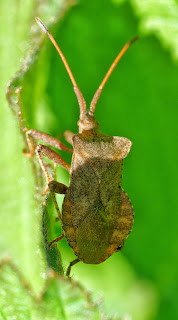A Wallcreeper turned up near Worth Matravers in November 1969 and stayed until April the next near. It wasn't until March 8th that the opportunity to try to see this bird arose with a place in KG's mauve Morris Minor. This was the first since 1938 and only the sixth ever so was a big draw for fourteen year old me and of course for everyone else!!
Sadly, being not only pre-digital but also pre-owning any camera, I've no pictures but there is some delightfully dated black and white footage from the BBC
here. Embarrassingly, after seeing this bird I checked out the seabirds and added Guillemot to my life list!!
Ten years later saw a visit to India and Nepal, mostly aimed at trekking part of the Langtang valley and this saw a total of seven Wallcreepers over four days with a maximum of four on one day.
May 2010 saw, as part of a Bulgarian Birdquest, a visit to Trigrad Gorge specifically for Wallcreeper. Some youtube footage of a bird at the gorge in May 2015
here. On arrival there was no sign of the bird until one of the group, a tail end Charlie, got a brief glimpse of it. The same happened later with another birder again getting the briefest of glimpses. Lunch ensued with a sound-background of Serins. One last attempt at the Wallcreeper before we needed to leave for the long drive to that night's accommodation saw us walking back through the tunnel and praying for a miracle. With time running out I took a walk down hill away from the group for a call of nature before the long drive only to find myself face to face with the target bird just yards away on the roadside parapet!! It flipped up onto the adjacent cliff face and performed nicely for everyone (see below).

A short visit to northern Spain in January 2011, specifically for Wallcreeper and Snowfinch, was a flop being defeated by fog and another slightly longer visit in May 2014 also failed to connect to either of these species with ice and snow closing roads into the Pyrenees; the only day the Pyrenees were accessible was a 'peas souper' with roadside Water Pipits being almost the only birds.
And so, onto Franklin's Gull.
Two or three weeks before the Wallcreeper jaunt in 1970 a Franklin's Gull was found at Farlington by Dave Billet but, being a potential first for Britain, ensured some research was needed before claiming it. A lack of grapevine, certainly amongst my teenage peers, meant that it was March 1st before I heard about it. On a lone visit to Farlington I bumped into a breathless birder whose name has long since slipped my memory. When asked if I'd seen the Franklin's I shrugged and said no, thinking to myself ' What the hell's a Franklin's'!! At this stage I didn't own a North American guide and had only seen one North American wader, a Lesser Yellowlegs at Chichester GPs four months earlier. Luckily, I met another birder a little later who put me right!!
Even more luckily the first birder and one or two others had relocated the bird on the St John's playing fields and I was given the opportunity to look through the only telescope present. The bird was again here a few days later and then on the 23rd was on the lagoon bathing giving much closer views. It was seen by numerous people over its twelve week stay.
British Bird account of this occurence
here
Texas, 1983, mentioned in an earler blog entry, gave the opportunity to catch up with species again with five pink-flushed adults at the famous Brownsville dump whilst searching for local specialties, Chihuahuan Raven and Tamaulipas Crow; another fifteen or so Franklin's were seen later on that trip.
Winding the clock forward to 2014, 44 years and 7 months later, saw Rob Hume finding Hampshire's second Franklin's Gull at Ibsley Water, Blashford on 18th October but sadly not seen again in subsequent days. Ten days later I flipped a coin between doing the Blashford gull roost or visting the nearby harrier roost. The latter won but in the end were no-shows whereas the Franklin's was found in the gull roost for the first time. November 1st saw large crowds waiting patiently and the bird eventually showed towards dusk but views through other people's scopes were less than satisfying. Finally, on the 17th I decided on setting up early afternoon in Tern Hide to get better views but as the afternoon wore on it became noisier and more claustrophobic as more and more people arrived. I gave up and went around to Goosander hide for some peace and driven by the urge to find the bird for myself. Luckily, only one other birder had the same idea and that, fortunately, was the finder Rob Hume!! With gulls arriving he pointed out a Little Gull and shortly after I picked up the Franklin's and, whilst not too close, gave decent scope views in nice light and on calm water. Mission accomplished and still the longest gap between individuals of a rarity to date.
Locally - photographing Wood Pigeons - things are getting desperate.
And the Peregrine is still roosting early evening in the same spot and never on the same brickwork as day-roosting; definitely a creature of habit.






































